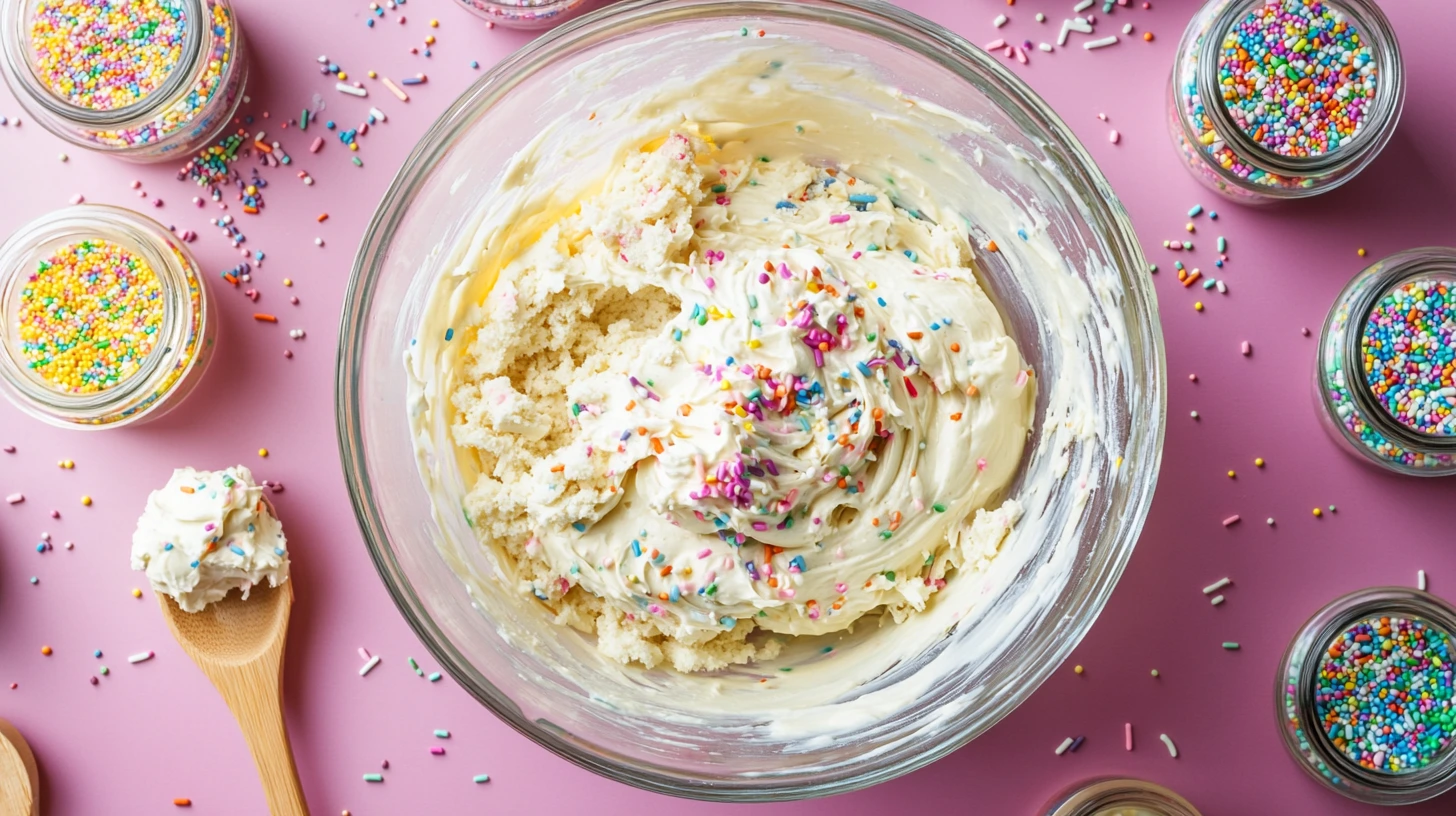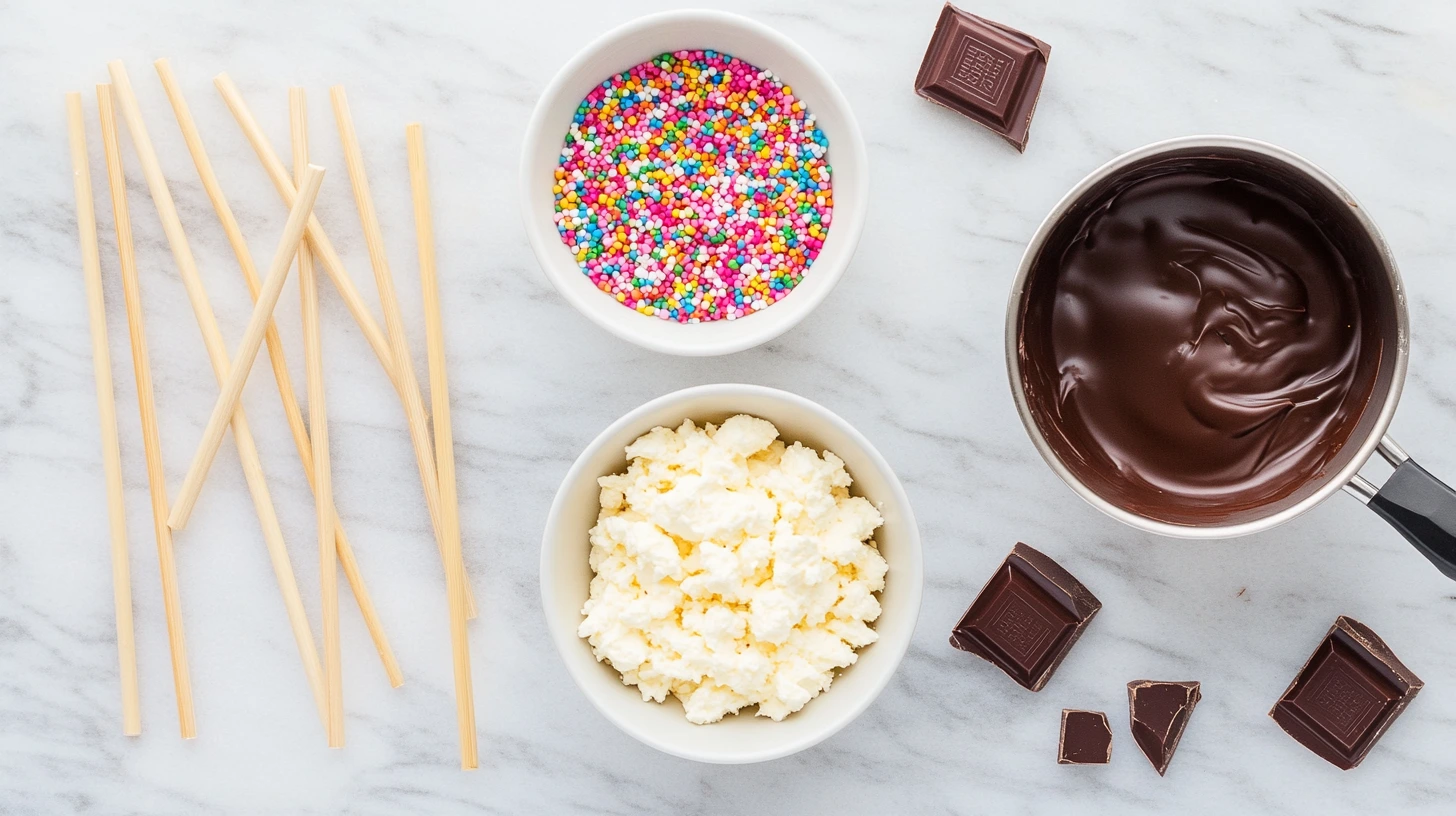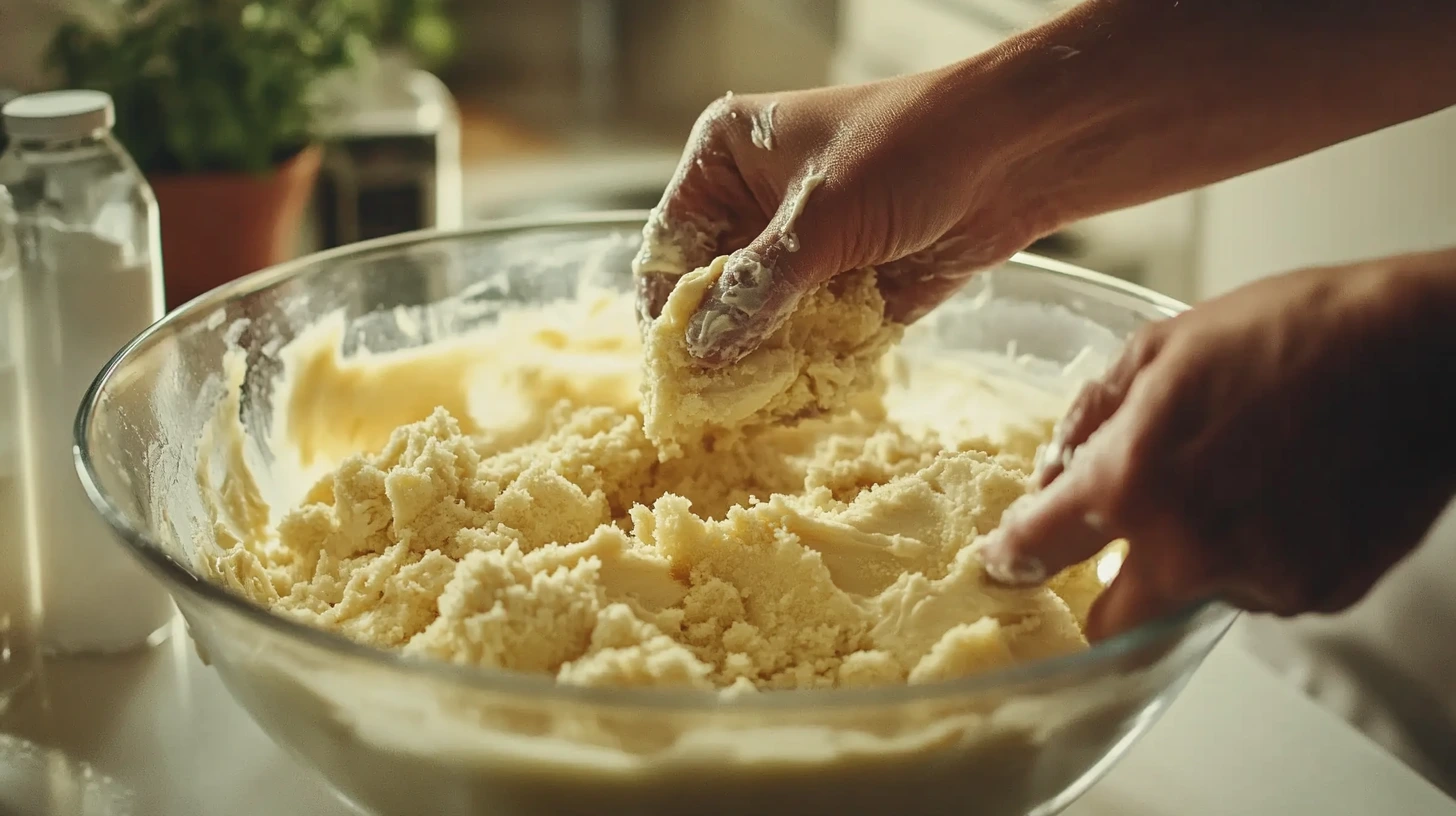What is Cake Pop Dough Made Of?

Introduction to Cake Pops
Cake Pop Dough are a delightful, bite-sized dessert that combines crumbled cake with Frosting to create a moist and flavorful dough. This dough is then shaped into balls or creative forms, placed on sticks, and coated with a smooth layer of chocolate or candy melts. They’re perfect for parties, celebrations, or even as a fun treat to make at home.
The simplicity of the ingredients—cake, Frosting, and coating—belies the endless possibilities for flavor and decoration. Whether using leftover cake or baking a fresh batch, cake pops are a fun and versatile way to enjoy a classic dessert in a new and exciting form.
Key Ingredients in Cake Pop Dough

The magic of cake pop dough lies in combining just a few simple ingredients, each serving a specific purpose. Understanding their roles will help you create perfectly textured and flavorful cake pops every time.
Cake Mix and Its Role in Cake Pops
Unsurprisingly, cake is the foundation of cake pop dough. You can use a store-bought cake mix for convenience or a homemade recipe for a more customized flavor.
- Purpose: The cake provides the base structure of the dough. Its moisture level and texture are critical for consistency when combined with Frosting.
- Tips: Use moist and flavorful cakes like vanilla, chocolate, red velvet, or lemon. Avoid overly dry cakes, as they can make the dough crumbly.
Frosting: The Binding Agent for Cake Pops
The Frosting holds the crumbled cake together, creating a cohesive dough that can be shaped into pops.
- Purpose: Acts as a binder, giving the dough its pliable texture.
- Tips: Add Frosting gradually, as too much can make the mixture overly sticky and hard to shape. Buttercream and cream cheese frostings are popular, but you can use other varieties to match your cake flavor.
Flavoring Additives: Essential Enhancers
While cake and Frosting form the core of the dough, additional flavoring can take your cake pops to the next level.
- Options: Vanilla extract, almond extract, citrus zest, or spices like cinnamon can enhance the taste.
- Purpose: Adds depth and uniqueness to the flavor profile of your cake pops.
- Tips: Use sparingly to avoid overpowering the natural flavors of the cake and Frosting.
The Role of Cake Pop Sticks
Although not part of the dough, cake pop sticks are essential for their presentation and ease of serving.
- Purpose: Provides stability, making cake pops easier to dip, decorate, and serve.
- Tips: Dip the end of each stick into the melted coating before inserting it into the dough ball. This creates a strong bond that prevents the pop from sliding off during dipping or eating.
How to Make Cake Pop Dough
Cake pop dough is the foundation of any excellent cake pop. Following these steps and tips, you can create the perfect dough with the right consistency for shaping and decorating.
Step-by-Step Guide to Making Cake Pop Dough
- Prepare the Cake
- Bake a cake using a mix or homemade recipe. Allow it to cool completely before handling, as warm cake can lead to a sticky, uneven texture.
- Pro tip: Moist cakes like vanilla, chocolate, or red velvet work best for cake pops.
- Crumble the Cake
- Break the cooled cake into fine crumbs using your hands, a fork, or a food processor.
- Ensure no large chunks can interfere with the dough’s consistency.
- Add Frosting Gradually
- Start with a small amount of Frosting (about 2-3 tablespoons). Add it to the crumbled cake and mix thoroughly using your hands or a spatula.
- Continue adding Frosting in small increments until the mixture reaches a dough-like consistency.
- Test the Dough
- The dough should hold its shape when pressed but not feel overly sticky. If it crumbles, add more Frosting. If it’s too sticky, try chilling the dough briefly before shaping.
Combining Cake and Frosting for the Perfect Dough
The cake and frosting combination is the heart of cake pop dough. Here’s how to ensure they blend seamlessly:
- Even Mixing: Use your hands for the best control, gently pressing and folding the mixture until it’s evenly combined.
- Temperature Matters: Work with room-temperature Frosting, as cold Frosting can be more complicated to mix.
Tips for Achieving the Right Consistency
- Add Frosting Gradually: Start small and add more as needed. Over-frosting can make the dough sticky and challenging to work with.
- Chill Before Shaping: If the dough feels too soft, chill it in the refrigerator for 15-20 minutes to firm it up.
- Consistency Test: Roll a small amount of dough into a ball. If it holds its shape without cracking or sticking excessively, it’s ready.
Variations in Cake Pop Dough

Cake pop dough is incredibly versatile, allowing endless customizations to suit dietary and flavor preferences. Here are some popular variations and tips for making them work.
Different Types of Cake Mixes for Cake Pops
The type of cake mix you use can significantly influence the flavor and texture of your cake pops.
- Classic Options: Vanilla, chocolate, red velvet, and confetti are popular and reliable choices for traditional cake pops.
- Creative Flavors: Experiment with lemon, spice, carrot, or coffee-flavored cakes for unique treats.
- Tips: Follow the cake mix instructions carefully and avoid overbaking for moist and flavorful results. To elevate the flavor, add extras like vanilla extract, cocoa powder, or citrus zest.
Gluten-Free Cake Pops: Adjustments to the Dough
Creating gluten-free cake pops is easy with a few substitutions and adjustments.
- Cake Base: Use a gluten-free cake mix or a homemade gluten-free cake recipe. Ensure that all ingredients, including Frosting and decorations, are certified gluten-free.
- Binding: Gluten-free cakes can be crumbly, so you may need to add more Frosting to achieve consistency.
- Tips: To reduce the risk of excess crumbling, let the cake cool completely before crumbling. Chill the dough before shaping to make it firmer and easier to handle.
Vegan Cake Pop Dough: Substituting Ingredients
Vegan cake pops are a fantastic option for those avoiding animal products.
- Cake Base: Use a vegan cake recipe or mix that replaces eggs with applesauce, mashed bananas, or flaxseed meal. Substitute dairy milk with plant-based options like almond, soy, or oat.
- Frosting: Choose vegan-friendly frostings made with dairy-free butter or shortening. Many store-bought frostings are vegan, but check the label to be sure.
- Tips: Vegan cakes tend to be softer, so handle the dough gently and chill before shaping for the best results.
How to Shape and Form Cake Pops
Shaping cake pops is a critical step in creating these delightful treats. Proper techniques and tools can help you achieve uniform shapes and professional results.
Molding Cake Pops: Techniques for Shaping
- Hand-Rolling:
- Using your hands, the most common method is to roll the cake and Frosting mixture into balls.
- Scoop equal portions of the dough (a small cookie scoop works well for consistency) and gently roll between your palms to form smooth, round balls.
- Avoid over-rolling, as the heat from your hands can make the mixture too soft.
- Using Molds:
- Silicone cake pop molds allow you to create uniform shapes easily. These are especially helpful if you want non-spherical designs like hearts or stars.
- Press the dough into the mold, smooth the surface, and gently release the shape.
- Freezing for Stability:
- After shaping, place the cake balls on a baking sheet lined with parchment paper and chill them in the refrigerator for 15-20 minutes. This helps them firm up and hold their shape better during dipping.
Best Tools for Cake Pop Formation
- Cookie Scoop: Ensures uniform sizing, essential for even cooking and a polished appearance.
- Silicone Molds: Ideal for creating creative and intricate shapes with minimal effort.
- Measuring Spoon: A tablespoon or melon baller can be used as a measuring tool to make precise portions of the dough.
- Parchment Paper: Prevents the shaped cake pops from sticking to the surface during chilling.
- Cooling Rack: Useful for holding shaped cake pops in place while dipping or decorating.
Decorating Cake Pops

Decorating cake pops is where creativity takes center stage. From smooth coatings to colorful sprinkles, the possibilities are endless for making your cake pops look as amazing as they taste.
Coating Cake Pops with Chocolate or Candy Melts
The coating is the canvas for your cake pop decorations, and achieving a smooth, glossy finish is key.
- Preparation:
- Melt chocolate or candy melts in a deep, narrow container for easy dipping. Use a microwave or double boiler, stirring frequently to prevent overheating.
- Then, the coating is needed, and a small amount of vegetable oil or shortening for a smoother consistency is added.
- Dipping:
- Hold the cake pop stick and dip the entire cake pop into the melted coating. Ensure it’s fully submerged for an even layer.
- Gently tap the stick on the edge of the container to remove excess coating, rotating the pop to keep the layer smooth.
- Drying:
- Place the dipped cake pops upright in a cake pop stand or a foam block to dry. To maintain a perfect finish, ensure they don’t touch each other.
Adding Toppings and Sprinkles to Cake Pops
Toppings and sprinkles add flair and personality to your cake pops.
- Applying Toppings:
- While the coating is wet, sprinkle on toppings like jimmies, nonpareils, or edible glitter. Work quickly, as the coating sets fast.
- For intricate designs, allow the first layer of coating to dry completely, then use a piping bag or spoon to drizzle additional chocolate or candy melts.
- Creative Ideas:
- Seasonal Themes: Use themed sprinkles or colors to match holidays or events, such as red and green for Christmas or pastels for Easter.
- Custom Shapes: For a sophisticated look, use small edible decorations like sugar pearls, edible flowers, or fondant shapes.
- Personalized Touches: Write names or messages using edible pens or icing for a customized treat.
Common Mistakes in Cake Pop Dough Preparation
Creating the perfect cake pop dough requires a balance of technique and attention to detail. Here are some common mistakes to avoid and tips to ensure success.
Overmixing or Undermixing Cake Pop Dough
How you combine the cake crumbs and Frosting can significantly affect the texture and workability of your dough.
- Overmixing:
- What Happens: Overmixing can result in dense, heavy dough lacking a light, cake-like texture. It may also make the cake pops overly compact, reducing their appeal.
- How to Avoid It: Mix the cake crumbs and Frosting until combined. The mixture should hold together without becoming overly sticky or dense.
- Undermixing:
- What Happens: Undermixing leaves dry crumbs and frosting unevenly distributed, making it challenging to form cohesive cake balls.
- How to Avoid It: Ensure all the crumbs are evenly coated with Frosting. Use your hands for better control and a more thorough mix.
Improper Consistency and What It Means
The right consistency is crucial for shaping and handling the cake pop dough.
- Too Wet or Sticky:
- What It Means: Adding too much Frosting makes the dough overly wet, sticky, and challenging to shape. This can also make the cake pop too sweet.
- Solution: Add Frosting gradually, and test the dough as you go. If the mixture becomes too sticky, chill it for 15-20 minutes to firm it up.
- Too Dry or Crumbly:
- What It Means: Insufficient frosting results in a dry, crumbly dough that won’t hold its shape.
- Solution: Add small amounts of Frosting until the dough holds together when pressed without cracking.
Storing and Preserving Cake Pop Dough
Proper storage is essential for preserving the quality of your cake pop dough, whether prepping in advance or saving leftovers. Here’s how to keep your dough fresh and ready for use.
How to Store Cake Pop Dough for Later Use
Storing cake pop dough properly helps maintain its texture and flavor.
- Short-Term Storage:
- To prevent the dough from drying out, place it in an airtight container or wrap it tightly in plastic wrap.
- You can storeYou can store it in the refrigerator for up to 3 days. Before shaping or using it, let the dough sit at room temperature for a few minutes to soften slightly.
- Pre-Shaped Balls:
- If you’ve already shaped the dough into balls, arrange them on a parchment-lined baking sheet and cover with plastic wrap or an airtight lid.
- Refrigerate for up to 2 days before coating and decorating.
Freezing Cake Pop Dough: Best Practices
Freezing cake pop dough is a convenient way to prepare in advance and ensure you always have some ready for future use.
- Freezing Unshaped Dough:
- Wrap the dough tightly in plastic wrap, then place it in a freezer-safe, airtight container or zip-top bag.
- Label the container with the date and freeze for up to 2 months. Thaw in the refrigerator overnight before using.
- Freezing Pre-Shaped Balls:
- Roll the dough into balls and arrange them on a parchment-lined baking sheet. Place the sheet in the freezer until the balls are firm (about 1-2 hours).
- Transfer the frozen cake balls to a freezer-safe container or bag, separating layers with parchment paper to prevent sticking.
- Freeze for up to 2 months. Thaw in the refrigerator for a few hours before dipping and decorating.
Frequently Asked Questions (FAQs)
Cake pops are a versatile and fun treat, but you may have questions about their preparation and storage. Here are answers to some of the most common inquiries.
What is the Best Way to Store Cake Pop Dough?
The best way to store cake pop dough is in an airtight container or wrapped tightly in plastic wrap to prevent it from drying out.
- Short-Term: Refrigerate for up to 3 days. Let it sit at room temperature for a few minutes before shaping.
- Long-Term: Freeze the dough in a freezer-safe container for up to 2 months. Thaw in the refrigerator overnight before use.
Can Cake Pop Dough Be Made in Advance?
Yes, cake pop dough is perfect for preparation. You can make the dough ahead of time and store it in the refrigerator or freezer. Pre-shaping and freezing the balls is a great way to save time when you’re ready to dip and decorate.
How Do I Know If My Cake Pop Dough Is Too Wet or Too Dry?
- Too Wet: If the dough feels sticky, overly soft, or hard to shape, it likely has too much Frosting. Chill the dough to firm it up, or add a small amount of additional cake crumbs.
- Too Dry: If the dough crumbles or doesn’t hold together when pressed, it needs more Frosting. Add a small amount and mix until the consistency is right.
Can I Make Cake Pops Without Using a Cake Mix?
Absolutely! You can bake a cake from scratch and use it as the base for your cake pops. Homemade cakes allow you to customize flavors and ingredients, allowing for unique and creative combinations. Just ensure the cake is moist and flavorful for the best results.
What Are Some Creative Cake Pop Flavor Ideas?
The possibilities for cake pop flavors are endless. Here are a few ideas to inspire you:
- Classic Options: Vanilla, chocolate, or red velvet.
- Seasonal Favorites: Pumpkin spice, peppermint, or gingerbread.
- Fruity Flavors: Lemon, strawberry, or coconut.
- Unique Combos: Cookies and cream, mocha, or salted caramel.
- Custom Creations: Add mix-ins like crushed cookies, candy pieces, or sprinkles to the dough for extra texture and flavor.
Conclusion
Summary of Cake Pop Dough Ingredients and Tips
Cake pop dough is a simple yet versatile combination of cake and Frosting that is the foundation for creating delightful treats. Key ingredients include:
- A moist cake base.
- Just enough Frosting to bind the mixture.
- Optional flavor enhancers for a unique touch.
Achieving the perfect consistency—pliable but not sticky—is essential for shaping and handling.
To ensure success:
- Gradually add Frosting to avoid overly wet or dry dough.
- Chill the dough before shaping for better stability.
- Use consistent portions and the right tools for uniform cake pops.
With the proper techniques, storage methods, and creativity, cake pops can be customized to suit any flavor preference or occasion. By following these tips, you’ll master the art of cake pop dough and create treats as fun to make as they are to eat. Happy baking!
